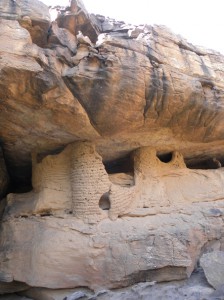Examples of Pégué A and Dourou-Boro
The “Toloy-Tellem-Dogon” chronocultural sequence established by the research of a team from the University of Utrecht in the caves of the Bandiagara Escarpment (Bedaux 1972) has been accepted for 40 years in the literature without critique despite the small amount of data and ambiguity in the discovery contexts. Our first archaeological work, begun in 1997 on the Bandiagara Plateau and the Séno Plain (Guindo 2011; Huysecom et al. 2010, 2011; Keita 2011; Loukou et al. 2013; Mayor 2003, 2011; Mayor et al. 2005; see list of publications and dissertations), has demonstrated the establishment of villages peopled with agropastoralists since the first centuries BC, entirely filling in the assumed cultural gap of more than a 1000 years. In 2007 and 2008, we continued research on the escarpment, examining raised coiled clay constructions, previously considered to be granaries typical of the Toloy occupation later reused for burials.
Our approach consisted in establishing a precise chronology of constructions of this type at two newly discovered sites, Dourou-Boro and Yawa-vaches, as well as at Cave at Pégué, previously studied but resampled during the current project. The method consisted in obtaining a series of radiocarbon dates on unburned short-lived plant elements that had been incorporated as temper in the clay. We also made detailed technical descriptions of the constructions, now considered to be primary tombs, and created a typology showing the development of three types over 1800 years, from the 4th century BC to the 14th century AD. In addition, analysis of a new ceramic assemblage from Dourou-Boro and reanalysis of the ceramics attributed to the Toloy phase (Bedaux & Lange 1983) allowed us to reconsider the cultural development that until now was accepted for the history of the Dogon Country. Finally, chemical analysis of glass beads discovered at Dourou-Boro sheds new light on the social complexity and extra-regional contacts of the populations living in the Dogon Country during the 1st mill. AD, particularly with the Middle East (Mayor, Huysecom, Ozainne, Magnavita 2014).

